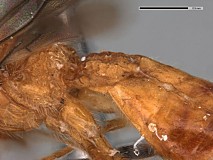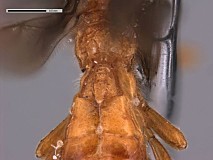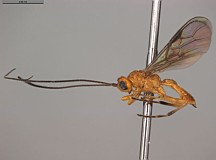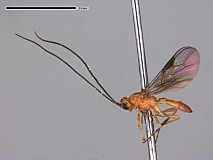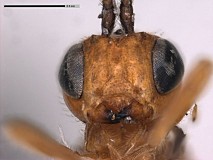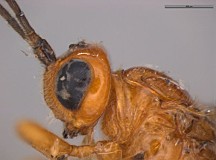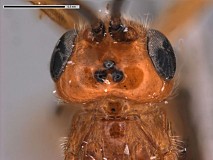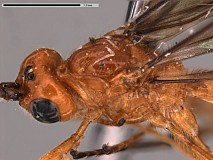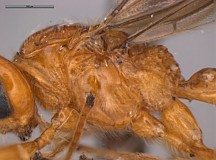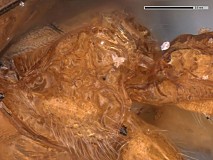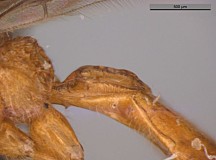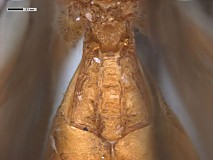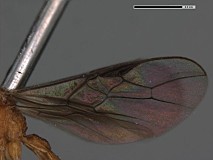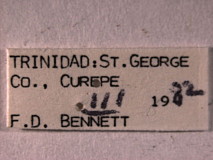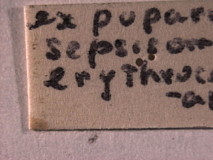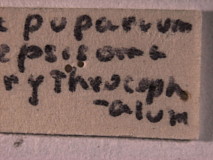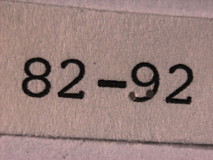Opius rojam Daniels and Wharton, 2013
The antennae are broken in paratypes from Costa Rica, but these specimens otherwise match the reared material from Trinidad. The male and female from Trinidad have approximately the same number of flagellomeres. The flagellomeres are more numerous than in the females of O. ingenticornis but fewer than in the male paratypes of ingenticornis as recorded by Fischer (1965)Fischer. The apparent difference in antennal length between the male and female of O. rojam from Trinidad, noted above, may be an artifact since the antennae are strongly curled apically in the female holotype and therefore difficult to measure accurately.
This species is nearly identical to O. ingenticornis Fischer, from which it differs primarily in sculpture. Most notably, T1 is extensively shagreened in O. ingenticornis and lacks coarsely rugose sculpture (Fig. 11). In O. rojam, T1 lacks evident shagreening and is coarsely sculptured throughout, including distinct transverse carinae between the dorsal carinae (Fig. 10). Opius rojam is also a slightly larger species, with somewhat darker wings. Both species are identical in color pattern (as in Fgis 1, 2, 11) and propodeal sculpture, and both have a relatively small second submarginal cell of the fore wing.
In addition to O. ingenticornis , O. rojam is also very similar to O. melchioricus and Opius gabrieli . All four species have very short ovipositors (as in Fig. 1), heavily sculptured propodea (as in Fig. 8), thinner, pale setae on the basal flagellomeres (as in Fig. 4), and are predominantly orange. Opius antennatus , O. matthaei , O. petri , and O. raphaeli are darker but otherwise share these features and together these eight species form a larger subgroup within the ingenticornis species group. Opius gabrieli is most readily recognized by the black apical metasomal terga relative to O. ingenticornis, O. melchioricus , and O. rojam. Opius ingenticornis and O. rojam are more uniformly orange and the face is more completely shagreened than in the other two species whereas O. melchioricus has the tegula black with dark transverse lines across the posterior margins of the meso- and metathorax. Opius filiflagellatus is similar to both O. ingenticornis and O. rojam in coloration and propodeal sculpture and thus superficially resembles these two species. The basal flagellomeres are covered with dark, thick setae, however, and thus O. filiflagellatus appears to belong to a different subgroup within the ingenticornis species group.
Mesosoma 1.5 x longer than high; 2.3 x longer than wide; 1.5–1.6 x higher than wide. Pronope deep, very large, posterior margin flattened, obliterating posterior transverse sulcus and broadly overlapping base of mesoscutum; pronotum laterally with shallow vertical groove lacking carinate anterior margin. Mesoscutum anteriorly on nearly same plane as pronotum, without distinct anterior declivity; with white, weakly decumbent setae around margins and extending in 1–2 rows along traces of notauli to posterior margin, becoming less densely clustered posteriorly; midpit absent. Notaulus deeply impressed as a short, curved line, not extending to anterior margin of mesoscutum, extending posterior-medially nearly to level of anterior margin of tegula; extending laterally towards tegula as groove bordered by very well-developed supramarginal carina. Scuto-scutellar sulcus rectangular, crenulate. Scutellum bare medially, setose laterally. Propodeum coarsely, carinately rugose, with short median trough anteriorly, areola indistinct, largely obscured by sculpture posteriorly; pleural sulcus irregular, mostly obscured by sculpture; propodeal spiracle equidistant from anterior and posterior margins. Mesopleuron smooth, polished, bare except posterior-ventrally; precoxal sulcus not evident in holotype, present in paratypes as short, faintly impressed, unsculptured groove. Metapleuron finely rugulose on ventral 0.5–0.6, with long, evenly covered with long, white setae.
Wings. Fore wing stigma wedge-shaped, discrete distally, approximately 3.6 x longer than wide; r1 shorter than stigma width, arising from basal 0.55 of stigma; 1RS (excluding parastigma) short, 0.15–0.2 x length of 1M; m-cu interstitial; second submarginal cell converging distally, 3RSa 1.15–1.3 x longer than 2RS; 1cu-a usually interstitial with 1M, weakly postfurcal in one female paratype. Hind wing m-cu completely absent; RS and M equally well-developed as pigmented lines.
Metasoma with T1 1.2–1.3 x longer than apical width, apex 1.7–1.9 x wider than base, length 2.9–3.4 x height at spiracle; sharply declivitous anteriorly, with deep, discrete basal depression; surface coarsely rugose; dorsal carinae distinctly elevated, nearly parallel-sided throughout, very weakly diverging posteriorly, not sinuate, transversely carinate between dorsal carinae; laterope large, deep. T2+3 uniformly shagreened, T4 more weakly and irregularly so. Ovipositor short; ovipositor sheath about 0.2-0.3 x length of mesosoma.
Color. Head, body, tegula, fore and mid legs, hind coxa, trochanter, trochantellus, femur, and basal 0.6–0.7 of tibia orange; remainder of hind leg, pretarsi of all legs, antenna, and ovipositor sheath dark brown to black; wings darkly infumate.
Male. Largely as in female with variation as follows: antenna 2.05 x longer than body, with 56 flagellomeres; mesosoma 2.4 x longer than wide; fore wing m-cu postfurcal; T1 with apex 2.0 x wider than base; metasomal tergum and genitalia black.
Body length 3.9–4.0 mm, fore wing length 4.0 mm, mesosoma length 1.45–1.55 mm.
Additionally, as in all other members of the ingenticornis species group, this species can be further characterized as follows: Mandible short, broadly triangular, dorsal margin strongly angled ventrally, broadly exposing labrum. Clypeus shaped as a broad crescent, nearly hemispherical, flat to weakly protruding ventrally, ventral margin shallowly concave, rarely appearing truncate. Malar sulcus distinct, complete. Antenna unusually long, approximately twice longer than body; first flagellomere slender, longer than second, with long, narrow plate sensilla. Occipital carina broadly absent dorsally, the gap in dorsal view at least as wide as distance between eyes; carina well developed laterally and ventrally, widely separated from hypostomal carina ventrally. Pronope deep, wide, posterior margin at least weakly overlapping base of mesoscutum, thus obliterating posterior transverse sulcus medially; vertical carina absent on pronotum laterally. Mesoscutum without midpit; notaulus short, curved, pit-like anteriorly, narrowing and evanescent posteriorly. Propodeum with median depression at least anteriorly, never with median longitudinal carina. Mesopleuron without sternaulus, precoxal sulcus unsculptured, absent or very faintly indicated; hind margin of mesopleuron not obviously crenulate on dorsal 0.5. Fore wing 2CUb arising from or near middle of first subdiscal cell. Hind wing with RS distinctly infumate; m-cu absent. T1 with dorsal carinae parallel or nearly so, extending from base to apex; laterope large, deep; dorsope absent.
There are no host records for any of the other members of the ingenticornis species group. The relative rarity of biological information on richardiids may explain this, and we therefore predict that most if not all of the members of this species group may eventually be found to utilize richardiids as hosts.
There are no specimens currently determined for this OTU, or those specimens determined for this OTU are not yet mappable.
This material is based upon work supported by the National Science Foundation under Grant Numbers DEB 0949027 with REU supplement 1213790.
Any opinions, findings, and conclusions or recommendations expressed in this material are those of the author(s) and do not necessarily reflect the views of the National Science Foundation.
